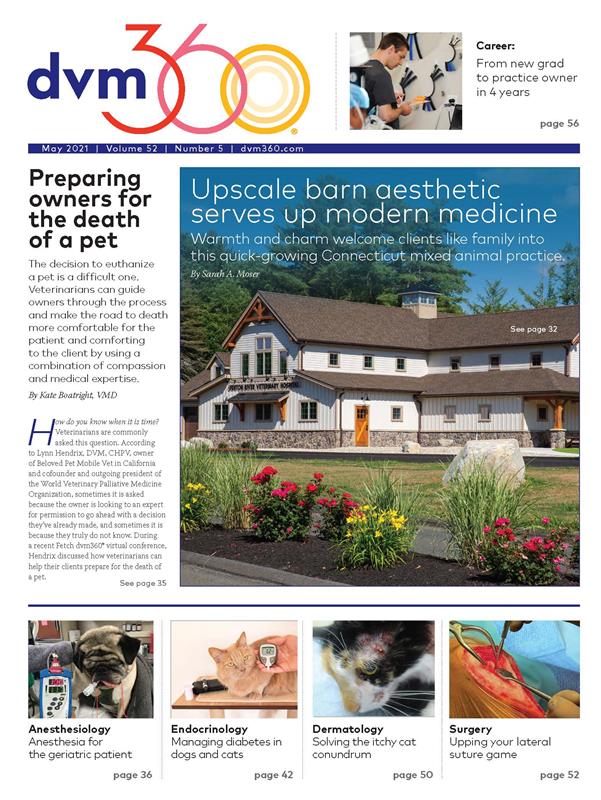A closer look at veterinary unions
National Veterinary Professionals Union President Liz Hughston, MEd, RVT, CVT, LVT, VTS (SAIM) (ECC), answers our questions about veterinary unionization.
Corporation-owned veterinary practices have been around since 1987, when VCA Animal Hospitals acquired its first independently owned companion animal clinic.These giant companies now make up roughly 10% of general veterinary practices and 40% to 50% of referral practices in the United States (numbers vary depending on the source).1
The downside to veterinary corporatization? According to Liz Hughston, MEd, RVT, CVT, LVT, VTS (SAIM) (ECC), a relief veterinary technician in San Jose, California, and president of the National Veterinary Professionals Union, it’s nearly impossible to voice your concerns owing to the multiple layers of management. She explained that this is extremely problematic for an industry in which many employees are underpaid and feel undervalued.
The COVID-19 pandemic has taken a huge toll on the veterinary profession. At the start, many practices were forced to close until deemed essential. Some practices struggled to stay afloat financially, leading to a series of layoffs. According to Hughston, that’s where veterinary unions come in. Not only do they help educate employees about their rights, but they advocate for employees who feel they’ve been wrongfully let go or otherwise mistreated.
dvm360® sat down with Hughston to talk about the benefits and challenges of unions in the veterinary profession, and why she believes they’re so valuable.
dvm360®:What are the pros of veterinary unions?
Hughston: The benefits of unions are threefold: solidarity, accountability, and wage transparency. Unions give you a voice at your workplace. It’s easy for management to discount 1 or 2 people, but when you’re in solidarity with your coworkers, they can’t ignore you.
Union members are allowed to have a witness present when discussing matters with management. I think it’s huge to have someone with you to listen and advocate for your rights. So, when a manager calls you in for a performance review, you can have someone there to oversee the conversation to ensure fairness.
Another pro for me is wage transparency, meaning you can go into a practice and see the wage structure. Most veterinary team members are not making a living wage. Most of us have 2 or 3 jobs or rely on a spouse or partner, or live with a bunch of roommates. To me, a living wage means being able to pay your rent or mortgage, purchase food, equipment, or clothes, and still have enough money left over to save or enjoy. Few veterinary staff members can do that with 1 job, and that’s not right. I went to school, I pay a licensing fee for continuing education, and I deserve to be compensated appropriately for that.
Almost every union contract is going to have a “just cause” clause that prevents an employer from firing an employee without a viable reason. In fact, individuals have to go through a process to ensure that the firing is legal and aligns with the National Labor Relations Act. Many people in management see this as a negative because they claim that the union protects unmotivated or lazy employees. I don’t think that’s true. I think the main issue is bad management practices. You don’t have good managers who are putting people on appropriate performance enhancement plans to ensure they’re meeting company expectations. None of us want to work with someone who’s not carrying their weight.
I believe unionization will lead to increased retention and less turnover. Burnt-out veterinary professionals are continually leaving this profession and switching over to human medicine and other careers. If we can pay them appropriately, utilize them better, enhance their benefits, and promote work-life balance, it can change our industry indefinitely.
dvm360®:What are the cons?
Hughston: Unionization is a lengthy process, mainly because we have a very itinerant workplace. People are constantly entering and leaving the profession for various reasons, mainly because of low pay, lack of utilization, etc.
Union members must pay dues. Some people see this as a con, but these dues are more than offset by the benefits unions provide, such as better pay and job protections. Unions aren’t in the business of getting people less money or fewer benefits. Dues are typically set up as a percentage of your annual income that’s withdrawn from your paycheck.
dvm360®:Do you see unions gaining a real foothold in veterinary medicine?
Hughston: I hope so. There are a lot of challenges and obstacles to unionization. Our itinerant workforce makes it difficult. These are long fights, so you have to find people who are passionate, engaged, and able to stick it out to the end. We’ve received a lot of pushback from corporations, which is not surprising. They wouldn’t be fighting so hard if they didn’t know that it would cost them money.
I am hopeful because there is a lot of interest in unionization in our field. A lot of people are feeling the pressures and are fed up with the lack of control and their voice not being heard and are coming to us for help.
dvm360®:What role do corporate practices play in the future of unions?
Hughston: My ultimate goal is to get more practices interested in organizing. That way, corporations like Mars will no longer need to negotiate with individual veterinary practices but instead can sit down with us and create a national contract for all of their practices.
Once we formulate a national contract, if you walk into any BluePearl, VCA, or Banfield facility, you'll know what you'll be paid and what your benefits and rights will be. If we can get to that point, these corporations will be models for how to treat employees in this industry. I think it will raise the bar for private practices because they will have to compete with these union practices.
I would like to see more corporations jump on this opportunity instead of fighting us every chance they get. I prefer to work collaboratively with them to improve the profession. And I think we can do it. These corporations can set the model for how we care for workers, patients, and clients.
Reference
- Nolen RS. The corporatization of veterinary medicine. American Veterinary Medical Association. November 14, 2018. Accessed April 5, 2021. https://www.avma.org/javma-news/2018-12-01/corporatization-veterinary-medicine

